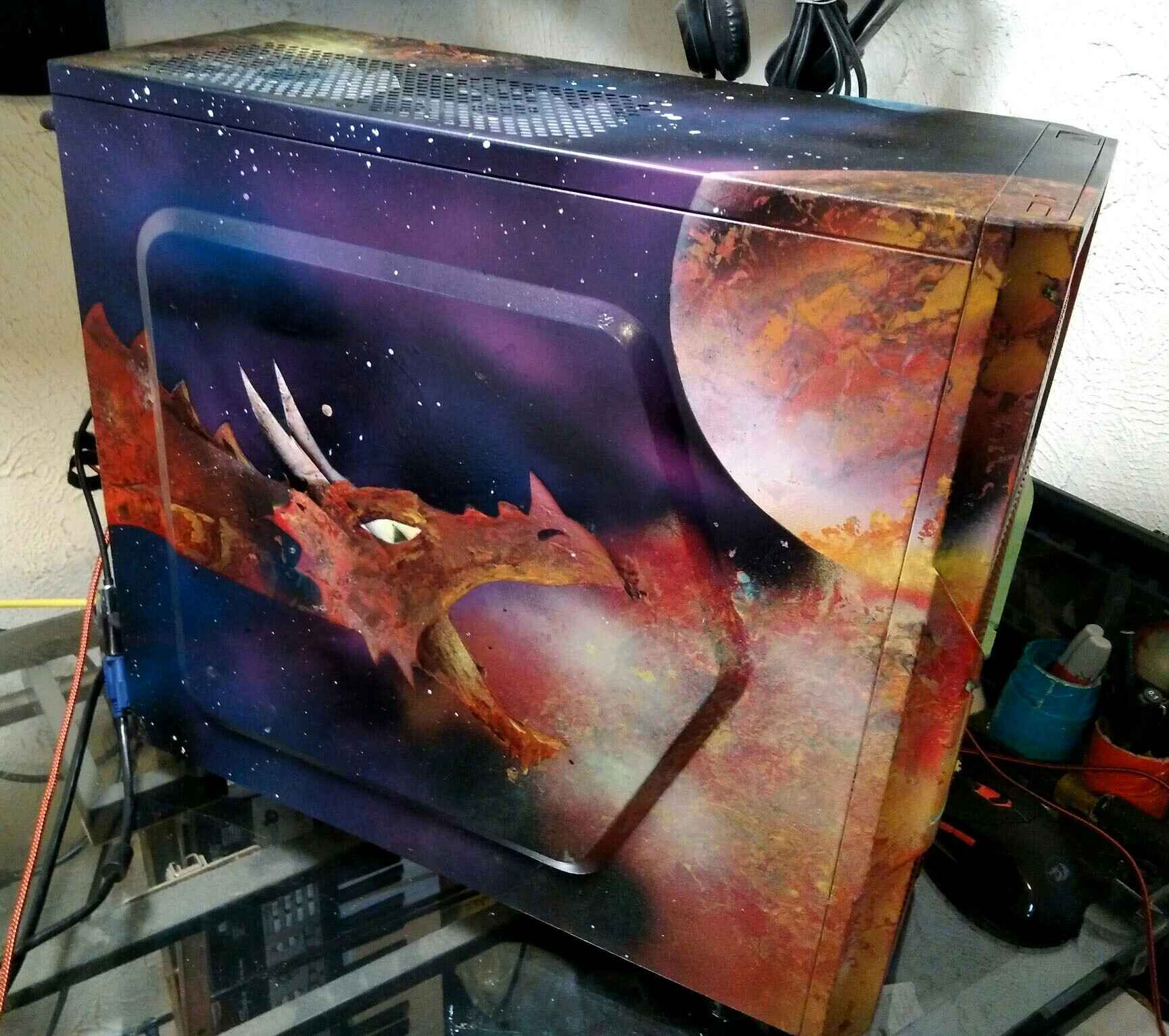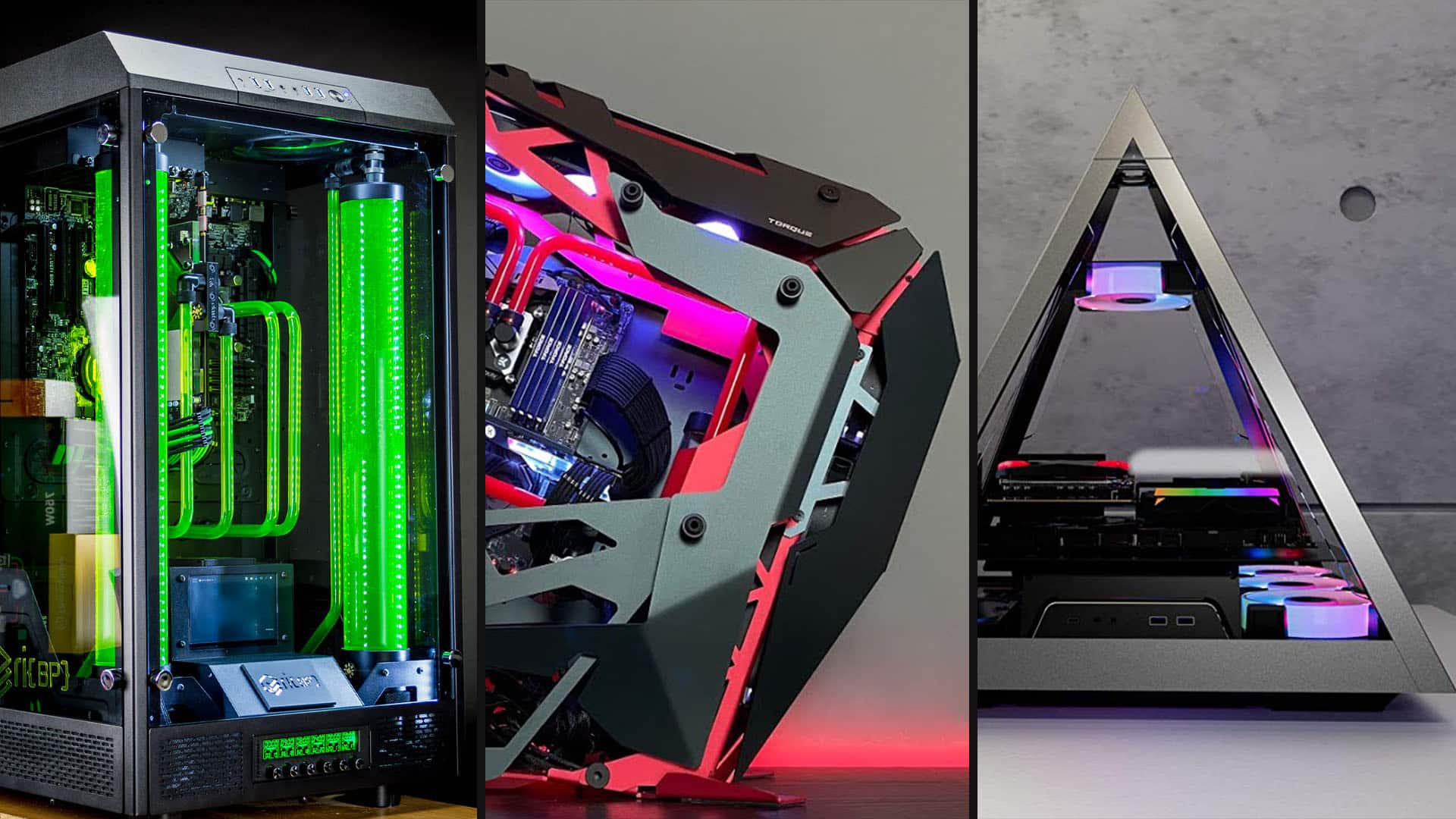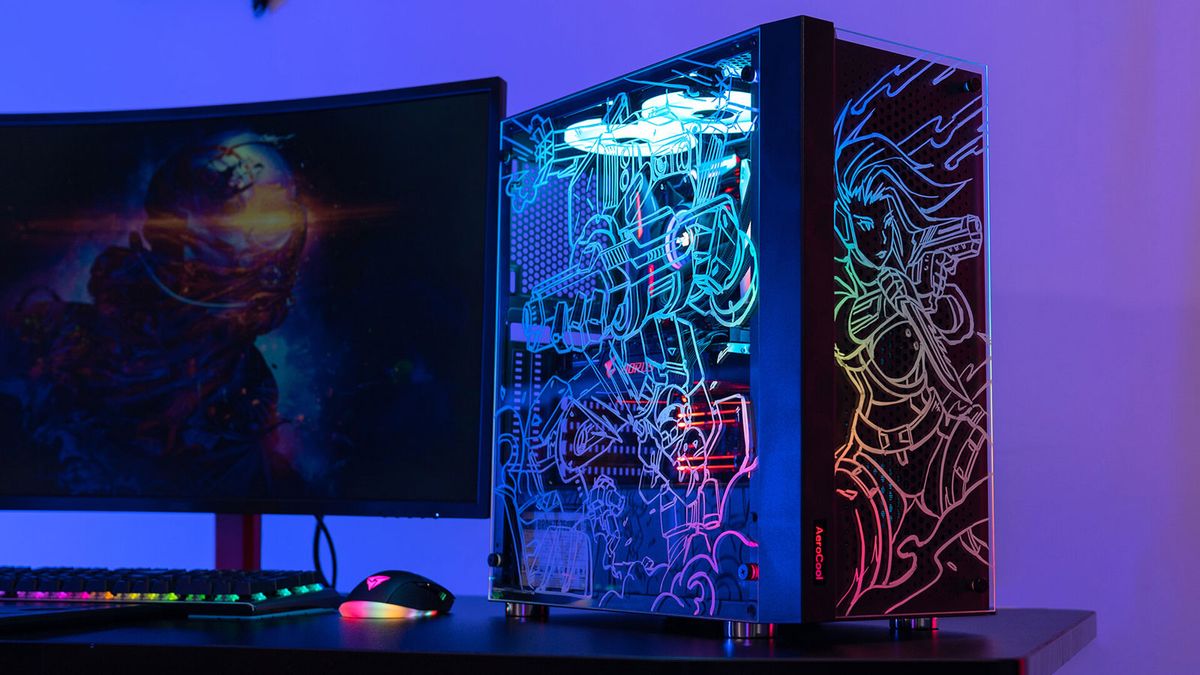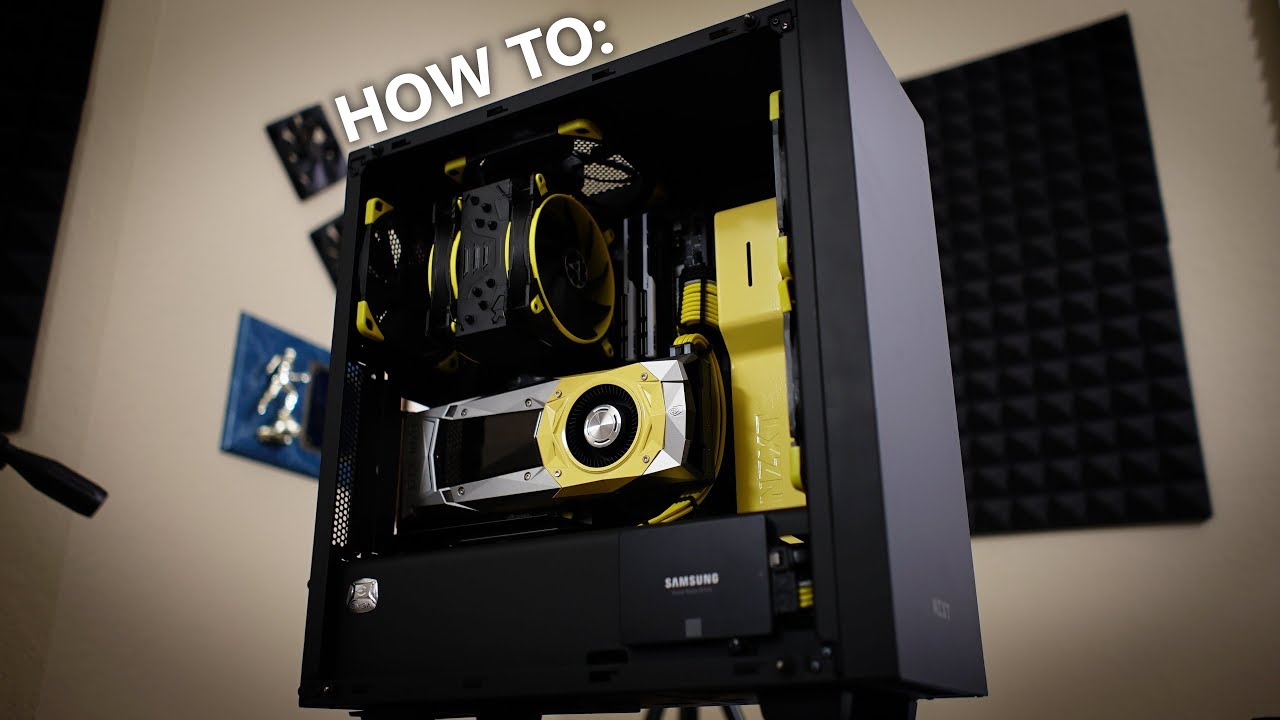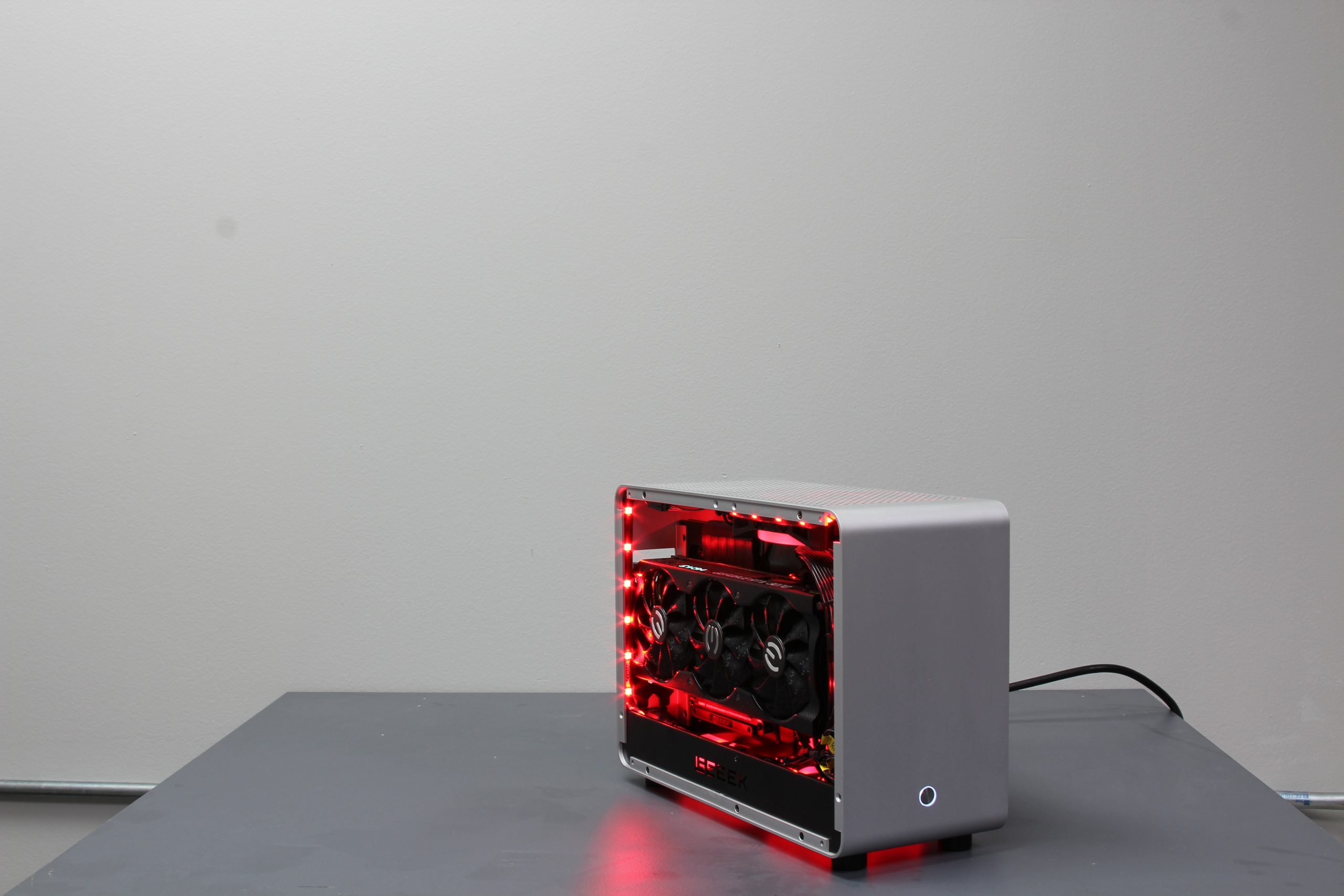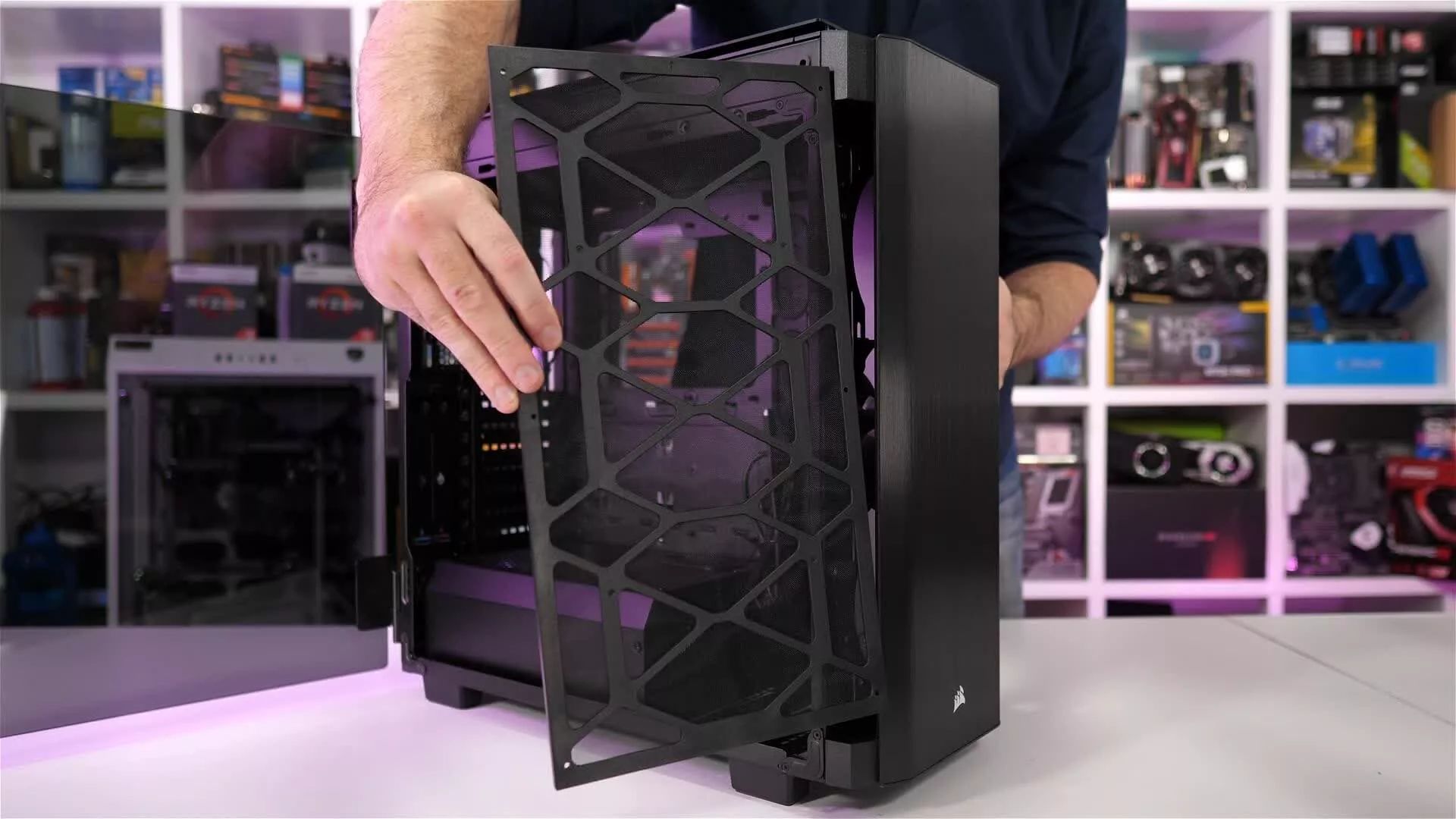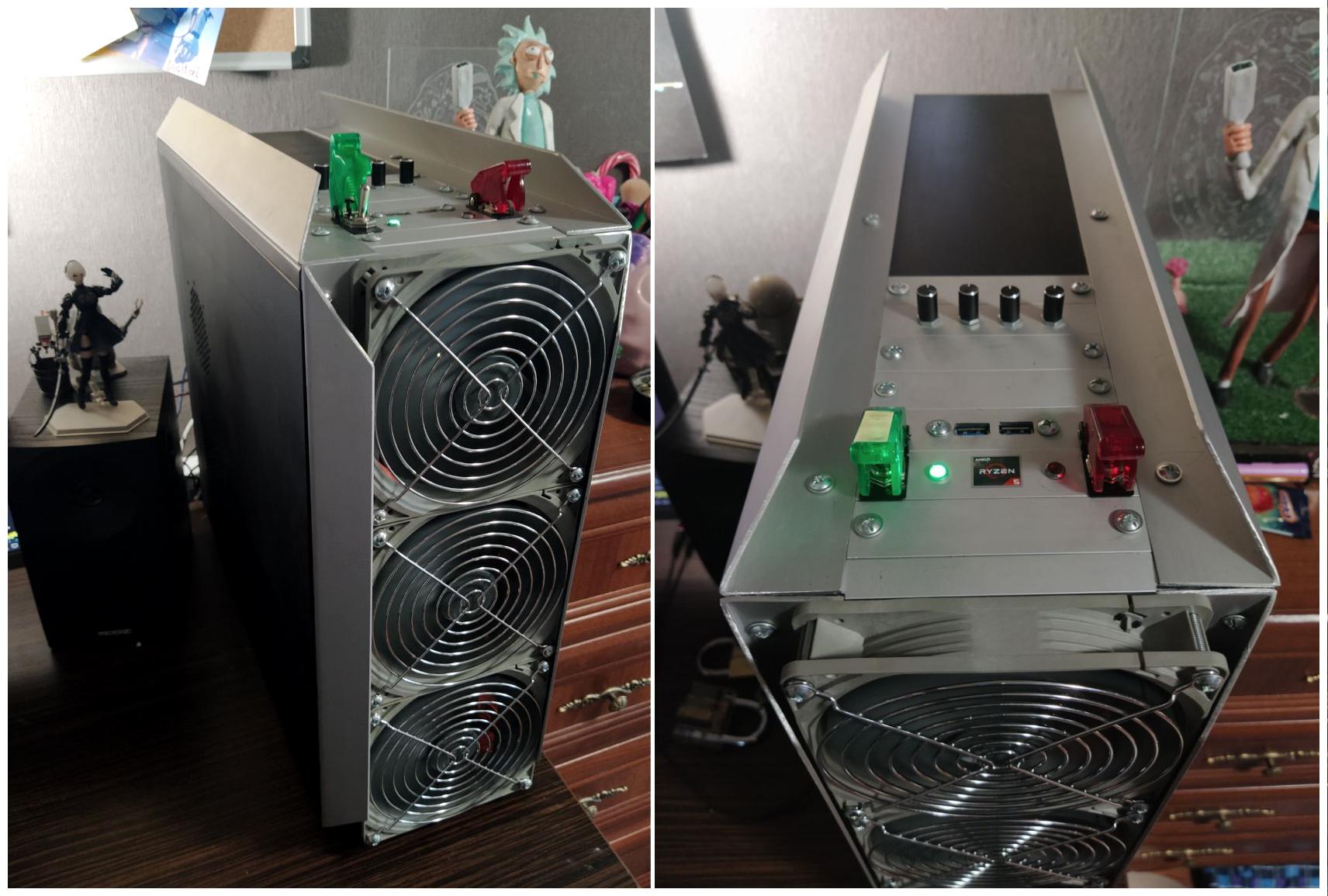Introduction
When it comes to personalizing your PC setup, a sleek and stylish PC case can make a significant impact. While there are a plethora of pre-designed cases available on the market, customizing your PC case with a fresh coat of paint can take your setup to a whole new level. Not only does painting your PC case allow you to showcase your creativity and personality, but it also offers the opportunity to create a unique look that sets your computer apart from the rest.
Choosing the right type of paint for your PC case is crucial to achieve a professional and long-lasting finish. With a wide range of options available, such as acrylic, enamel, spray paint, and powder coating, it’s essential to understand the pros and cons of each type and choose the one that best suits your needs.
In this article, we will discuss the different types of paint for PC cases and guide you through the process of selecting and applying paint to ensure a successful and visually appealing result. Whether you’re a seasoned PC enthusiast or a beginner looking to personalize your first build, this article will provide valuable insights and tips to help you achieve the desired look for your PC case.
Types of PC cases
Before delving into the different types of paint for PC cases, let’s briefly discuss the various types of PC cases available on the market. PC cases come in various shapes, sizes, and designs, catering to different requirements and preferences.
1. Tower cases: Tower cases are the most common type of PC cases and come in two variants: mid-tower and full-tower. Mid-tower cases are the standard choice for most PC builders, offering a balance between size and expansion potential. Full-tower cases, on the other hand, are larger and provide ample space for multiple graphics cards, storage drives, and other components.
2. Small form factor (SFF) cases: SFF cases are compact and designed to save space. They are ideal for those looking for a portable or space-efficient PC setup. SFF cases come in various sizes, including mini-ITX and micro-ATX, and are suitable for building powerful systems in a smaller footprint.
3. Open-air cases: Open-air cases, also known as test benches, provide a unique and minimalist design approach. These cases have an open structure, allowing for easy component access and improved airflow. Open-air cases are popular among PC enthusiasts and overclockers.
4. Water-cooling cases: Water-cooling cases are specifically designed to accommodate custom water-cooling loops. These cases feature specialized mounting options, additional fan placements, and radiator support to ensure efficient cooling for high-performance systems.
5. Showcase cases: Showcase cases are designed to prioritize aesthetics and showcase the internals of the PC. They often feature tempered glass panels on one or more sides, allowing users to display their components and RGB lighting effects.
These are just a few examples of the types of PC cases available in the market. Each type has its own advantages and considerations, depending on your specific needs and preferences.
Importance of paint in PC cases
Painting your PC case goes beyond just aesthetics; it serves as an essential element of customization and protection. Here are some reasons highlighting the importance of paint in PC cases:
1. Personalization: Adding a fresh coat of paint to your PC case allows you to express your personal style and make your system stand out from the rest. Whether you prefer a sleek matte finish, vibrant colors, or a unique design, painting your PC case gives you the freedom to create a truly personalized and eye-catching look that reflects your personality.
2. Protection: PC cases are typically made of metal or plastic, and over time, they can become susceptible to scratches, scuffs, and other forms of wear and tear. By painting your PC case, you provide an extra layer of protection, shielding it from physical damage and prolonging its lifespan.
3. Camouflage: Painting your PC case can help camouflage any imperfections or blemishes on the surface. It allows you to cover up scratches, dents, or outdated color schemes, giving your case a fresh and rejuvenated appearance.
4. Brand representation: For gamers and PC enthusiasts who have a dedicated brand preference, painting your PC case in the brand’s signature colors or incorporating its logo can further enhance the overall theme and serve as a representation of your loyalty to that brand.
5. Increased resale value: If you plan to sell your PC case in the future, a well-painted and visually appealing case can significantly increase its resale value. Buyers often appreciate customized cases that stand out, making them willing to pay a premium for a unique and well-maintained system.
6. Creativity and artistic expression: Painting your PC case offers an outlet for creativity and artistic expression. It allows you to experiment with different color schemes, patterns, or even create custom designs that reflect your artistic vision. The process of painting your PC case can be a fun and rewarding DIY project, allowing you to unleash your inner artist.
Overall, painting your PC case offers numerous benefits, ranging from customization and protection to brand representation and artistic expression. It is an integral part of the PC customization process that adds a personal touch and elevates the aesthetics of your system.
Types of paint for PC cases
When it comes to painting your PC case, choosing the right type of paint is crucial to achieve a durable and professional-looking finish. Here are some of the commonly used types of paint for PC cases:
1. Acrylic paint: Acrylic paint is a popular choice for painting PC cases due to its versatility and ease of use. It is water-based, quick-drying, and available in a wide range of colors. Acrylic paint sticks well to surfaces, including metal and plastic, and provides a smooth and even finish. It is also relatively affordable and can be easily applied with a brush or spray gun.
2. Enamel paint: Enamel paint is another option for painting PC cases, known for its durability and resistance to chipping and scratching. Enamel paint offers a high-gloss finish and is available in a variety of colors. It requires longer drying times compared to acrylic paint and may need to be applied in thin coats to avoid drips or uneven coverage. It is ideal for those looking for a glossy and long-lasting finish.
3. Spray paint: Spray paint is a convenient option for painting PC cases, especially if you want to achieve a smooth and professional-looking finish. Spray paints are available in various types, including acrylic, enamel, and metallic finishes. They offer excellent coverage and are easy to apply, providing a consistent coat of paint. However, it is crucial to ensure proper ventilation and apply multiple thin coats to avoid drips or uneven coverage.
4. Powder coating: Powder coating is a more complex and professional method of painting PC cases. It involves applying dry powder to the surface and then baking it in a specialized oven to create a durable and resistant finish. Powder coating offers excellent durability, chemical resistance, and a wide range of colors and finishes to choose from. However, it requires specialized equipment and a controlled environment, making it more suitable for individuals with experience or seeking professional services.
These are just a few examples of the types of paint used for painting PC cases. When choosing a suitable paint, consider factors such as the desired finish, durability, ease of application, and your budget. It is also essential to select paints that adhere well to the material of your PC case, ensuring a long-lasting and professional-looking result.
Acrylic paint
Acrylic paint is a popular choice for painting PC cases due to its versatility and ease of use. Here is a closer look at the characteristics and benefits of using acrylic paint:
1. Versatility: Acrylic paint is available in a wide range of colors, allowing you to choose the perfect shade to match your desired aesthetic. Additionally, acrylic paint can be easily mixed, giving you the freedom to create custom colors and gradients for a truly unique look.
2. Quick-drying: One of the main advantages of using acrylic paint is its fast drying time. This allows you to apply multiple coats or work on intricate designs without waiting too long between layers. It also reduces the risk of dust or debris settling on the painted surface during the drying process.
3. Adhesion: Acrylic paint bonds well to various surfaces, including metal and plastic, making it suitable for painting PC cases. With proper surface preparation, acrylic paint can create a strong and durable bond, ensuring that the paint does not chip or peel off easily.
4. Easy application: Acrylic paint is user-friendly and can be applied using various methods, such as brush, roller, or even airbrush. This makes it accessible to both beginners and experienced painters. It is also easy to clean up with just soap and water, minimizing the mess and making the painting process more enjoyable.
5. Smooth finish: Acrylic paint dries to a smooth finish, giving your PC case a sleek and polished look. It can be applied in thin layers, allowing for precise control over the coverage and avoiding excessive build-up or dripping. Acrylic paint can also be sanded and buffed to achieve an even smoother surface if desired.
6. Cost-effective: Acrylic paint is generally more affordable compared to other types of paint, making it a cost-effective option for painting PC cases. It is readily available in art supply stores or online, and a little goes a long way, providing excellent coverage and color payoff.
When using acrylic paint for your PC case, keep in mind that it may not offer the same level of durability as some other types of paint. To ensure longevity, consider applying a clear topcoat or sealant specifically designed for acrylic paint to protect it from scratches and everyday wear.
Overall, acrylic paint is a versatile and beginner-friendly option for painting PC cases. Whether you want to achieve a solid color or experiment with custom designs, acrylic paint provides excellent adhesion, quick drying time, and a smooth finish, allowing you to personalize your PC case to your heart’s content.
Enamel paint
Enamel paint is another popular option for painting PC cases, known for its durability and resistance to chipping and scratching. Here’s a closer look at the characteristics and benefits of using enamel paint:
1. Durability: Enamel paint is known for its exceptional durability, making it an excellent choice for painting PC cases. It forms a hard and protective coating that can withstand daily use and handling without easily chipping or flaking off.
2. High-gloss finish: Enamel paint provides a glossy and smooth finish, giving your PC case a professional and polished look. The high-gloss sheen adds depth and enhances the appearance of the painted surface, making it visually appealing.
3. Chemical and moisture resistance: Enamel paint offers good resistance to chemicals and moisture, which is especially beneficial in protecting your PC case from spills, splashes, and environmental factors. This resistance helps prevent discoloration, corrosion, and other damage that could affect the appearance and longevity of your PC case.
4. Coverage and opacity: Enamel paint typically offers excellent coverage, meaning fewer coats are necessary to achieve an even and opaque finish. This is particularly advantageous when working with darker base colors or when covering up previous paint jobs on your PC case.
5. Longer drying time: Enamel paint usually requires longer drying times compared to acrylic paint. It is important to be patient during the drying process to avoid smudging or damaging the freshly painted surface. Applying thin coats and allowing sufficient drying time between layers can help you achieve optimal results.
6. Suitable for various surfaces: Enamel paint adheres well to a variety of surfaces, including metal and plastic, making it a versatile option for painting PC cases. Proper surface preparation, such as cleaning and priming, is essential to ensure optimal adhesion and longevity of the enamel paint on your PC case.
While enamel paint offers excellent durability and a glossy finish, it is important to note that it requires proper ventilation and caution during application due to its strong odor and potentially hazardous fumes. Working in a well-ventilated area with proper protective gear is essential when using enamel paint.
Overall, enamel paint is a reliable choice for those seeking a durable and high-gloss finish for their PC case. The resistance to chipping, chemicals, and moisture, combined with its coverage and opacity, makes enamel paint a popular option among PC enthusiasts who want a long-lasting and visually appealing painted PC case.
Spray paint
Spray paint is a convenient and popular choice for painting PC cases, especially for those who want to achieve a smooth and professional-looking finish. Here are some key aspects and benefits of using spray paint:
1. Ease of application: One of the main advantages of spray paint is its ease of application. With a can of spray paint, you can achieve even coverage and a smooth finish without the need for brushes or other tools. The aerosol form allows for quick and efficient application, making it a time-saving option for painting PC cases.
2. Wide range of colors and finishes: Spray paint is available in a vast array of colors, including metallic and specialty finishes. This variety allows for greater customization when selecting the perfect shade or effect for your PC case. Additionally, some brands offer specific lines of spray paint designed for use on metal or plastics, ensuring optimal adhesion and durability.
3. Excellent coverage: Spray paint generally provides solid coverage, enabling you to achieve a uniform color on your PC case with fewer coats. The fine mist that spray paint produces allows for an even distribution of paint, minimizing the risk of streaks or brush marks often associated with using traditional brushes or rollers.
4. Smooth and professional finish: Spray paint offers a smooth and professional-looking finish when applied correctly. The aerosol application tends to result in a seamless coat of paint that can give your PC case a sleek and polished appearance. However, it is important to apply multiple thin coats to avoid drips or pooling, ensuring a flawless finish.
5. Quick drying time: Spray paint typically dries faster compared to other types of paint, allowing for multiple coats or additional detailing work to be done without significant delays. However, it is essential to note that the actual drying time can vary based on environmental factors, such as humidity and temperature.
6. Accessibility: Spray paint is widely available at hardware stores, home improvement centers, and online retailers. It offers convenience and accessibility, making it a popular choice for hobbyists and DIY enthusiasts looking to paint their PC cases.
When using spray paint, it is important to follow the instructions on the can carefully. Proper surface preparation, such as cleaning and priming, is crucial to ensure optimal adhesion and longevity of the paint. Additionally, adequate ventilation is essential when using spray paint to ensure safety and avoid inhalation of fumes or overspray.
In summary, spray paint provides convenient and efficient coverage, allowing for a smooth and professional finish on your PC case. With a wide range of colors and finishes available, spray paint offers great flexibility in customization while minimizing the need for specialized tools or techniques.
Powder coating
Powder coating is a professional method of painting PC cases that offers durability and a wide range of color options. Here is an overview of powder coating and its benefits:
1. Durability: Powder coating provides a durable and robust finish for PC cases. This process involves applying a dry, powdered pigment electrostatically and then curing it in a specialized oven. The result is a tough, chip-resistant coating that can withstand everyday wear and tear, making it an excellent choice for those seeking long-lasting protection for their PC case.
2. High-quality finish: Powder coating offers a high-quality, uniform finish with a wide range of color choices. The powder is available in various shades, including metallic and textured finishes, allowing for customization and achieving the desired aesthetic for your PC case.
3. Chemical and impact resistance: Powder coating exhibits excellent resistance to chemicals, impacts, and abrasions. This makes it an ideal choice for PC cases that may come in contact with liquids, cleaning agents, or accidental impacts during transportation or handling. The protective coating helps to prevent damage and maintain the appearance of your PC case for an extended period.
4. Environmental benefits: Powder coating is known for being an environmentally friendly painting method. Unlike traditional liquid paints, it does not require harmful solvents or emit volatile organic compounds (VOCs), reducing the impact on air quality. Additionally, any excess powder can be collected and reused, minimizing waste.
5. Wide range of applications: Powder coating is not limited to PC cases; it can be used on various metal and plastic surfaces, including case accessories, brackets, and other components. This versatility allows you to achieve a cohesive and professional look for your whole PC setup.
6. Professional results: While powder coating can be done at home with the right equipment, it is often performed by professional coating companies. By having your PC case powder coated by experts, you can ensure a flawless, factory-like finish. Professional finishers have the expertise and proper equipment to achieve optimal adhesion and curing, resulting in a high-quality and professional outcome.
It is essential to note that powder coating requires specialized equipment and space for the application and curing process. Therefore, it may not be suitable for beginners or those without proper resources. Consulting with professional powder coaters can help you determine if this method is feasible and cost-effective for your PC case customization project.
In summary, powder coating provides a durable and high-quality finish for PC cases, offering resistance to impacts, chemicals, and abrasions. With its wide range of color options and environmental benefits, powder coating is an excellent choice for those seeking a professional and long-lasting coating for their PC case.
Choosing the right paint for your PC case
Choosing the right paint for your PC case is crucial to achieve the desired look and ensure long-lasting results. Here are some factors to consider when selecting the paint:
1. Material compatibility: Different PC cases are made from various materials, such as metal or plastic. It’s essential to choose a paint type that is compatible with the material of your PC case. Some paints, like acrylic or enamel, adhere well to both metal and plastic surfaces, while others may require specific primers or adhesion promoters for optimal results. Checking the instructions and recommendations from the paint manufacturer is crucial to ensure proper adhesion and durability.
2. Desired finish: Consider the type of finish you want to achieve on your PC case. Whether you prefer a glossy, matte, metallic, or textured finish, there are paints available to suit your preferences. Some paint types, such as spray paint, offer a wide range of finishes, providing greater customization options.
3. Durability: Determine the level of durability you require for your PC case. If you anticipate a lot of handling, transportation, or exposure to environmental factors, opt for paints known for their durability, such as enamel or powder coating. These paints offer excellent resistance to chipping, scratching, chemicals, and moisture, ensuring your PC case remains in good condition over time.
4. Application method: Consider your comfort level and expertise with different application methods. If you are a beginner or prefer a simplified process, spray paint or acrylic paint applied with a brush may be more suitable. If you have the necessary equipment and experience, powder coating can provide a professional and long-lasting finish, but it requires a more involved application process.
5. Budget: Set a budget for your PC case painting project. Different types of paint come at various price points. Consider not only the cost of the paint but also any additional supplies or equipment needed for application. While some specialized paints or finishes may be more expensive, they can offer unique effects or enhanced durability.
6. Time and convenience: Evaluate the time and convenience factors. Some paints may require longer drying times or multiple coats, while others offer quick-drying and easy application. Consider your schedule and the amount of time you can dedicate to the painting process, as well as the level of convenience you seek.
It is important to consider these factors and weigh your priorities when choosing the right paint for your PC case. If you are unsure, consult with paint professionals or experienced PC enthusiasts who can provide guidance based on their own experiences.
Remember, proper surface preparation, such as cleaning and priming, plays a significant role in achieving successful paint adhesion and longevity. Follow the instructions provided by the paint manufacturer and take the necessary precautions to ensure a smooth and professional-looking finish for your PC case.
Preparing the PC case for painting
Proper preparation is key to achieving a smooth and long-lasting paint finish on your PC case. Before starting the painting process, follow these steps to prepare your PC case:
1. Disassemble the PC case: Begin by disassembling your PC case as much as possible. Remove any panels, side panels, front panels, or other removable parts from the case. This will allow for easier access to all the surfaces that need to be painted and ensure a more even application of paint.
2. Clean the PC case: Thoroughly clean the PC case to remove any dirt, dust, grease, or other contaminants that could interfere with paint adhesion. Using a mild detergent or a specialized PC case cleaner, gently scrub the surfaces with a soft cloth or sponge. Pay attention to the corners, crevices, and areas that are typically overlooked. Rinse the case with clean water and allow it to dry completely before proceeding.
3. Sand the surfaces (if needed): If your PC case has any existing paint or coatings that need to be removed or roughened up, sanding may be necessary. Use sandpaper or a sanding sponge to gently sand the surface, focusing on areas where the paint is chipping or peeling. This will create a smooth and roughened surface that promotes better paint adhesion. After sanding, remove any dust or debris from the case with a damp cloth.
4. Perform any necessary repairs: Assess the PC case for any structural or cosmetic repairs that need to be addressed before painting. Repair any dents, scratches, or damages using suitable fillers or compounds. Allow the repairs to dry and sand them lightly to ensure a smooth surface.
5. Mask and protect sensitive components: Use masking tape or painter’s tape to cover any sensitive components, connectors, or areas that you do not want to be painted. This includes openings for ports, hinges, or areas with delicate wiring. Make sure to apply the tape properly to achieve clean and precise lines.
6. Prime the PC case (optional): Depending on the type of paint you plan to use, applying a primer may be beneficial. Primer enhances paint adhesion, fills minor imperfections, and promotes a more even color and finish. Choose a primer specifically designed for the material of your PC case and apply it according to the manufacturer’s instructions. Allow the primer to dry completely before moving on to the painting stage.
By following these preparation steps, you will create an ideal surface for paint adhesion and ensure a smooth and professional-looking finish for your PC case. Taking the time to properly prepare your PC case will help to maximize the longevity and durability of the paint, ensuring that it remains in great condition for years to come.
Applying the paint
Once you have prepared your PC case, it’s time to apply the paint. Follow these steps to achieve a successful paint application:
1. Choose the appropriate application method: Depending on the type of paint you’ve selected, choose the most suitable application method. Paint can be applied using brushes, rollers, or aerosol spray cans. Consider factors such as the size of the area, desired finish, and your level of expertise to determine the best method for your PC case.
2. Start with thin coats: When applying paint, start with thin coats rather than trying to achieve full coverage with a single thick coat. Thin coats help prevent drips, runs, and uneven coverage. Allow each coat to dry completely before applying the next one, following the drying time recommended by the paint manufacturer.
3. Apply in a well-ventilated area: Ensure that you are working in a well-ventilated area, preferably outdoors or in a well-ventilated workshop. Proper ventilation helps to prevent the build-up of fumes and ensures a safe environment for both you and the paint application. Consider using respiratory protection if necessary.
4. Maintain even strokes or patterns: Use smooth and even strokes or patterns when applying paint to maintain consistency across the entire surface. Avoid applying too much pressure or going over the same area repeatedly, as this can result in uneven coverage or visible brush strokes.
5. Overlap each stroke: If using a brush or roller, slightly overlap each stroke to ensure even coverage and avoid leaving any gaps or lines between strokes. This technique helps to create a seamless and professional-looking finish.
6. Allow proper drying time: Patience is important during the drying process. Allow each coat of paint to dry fully before handling the PC case or applying additional coats. Rushing the drying process can lead to smudging, fingerprints, or damage to the paint surface. Refer to the paint manufacturer’s instructions for the recommended drying time.
7. Inspect for any touch-ups: Once the paint has dried, inspect the PC case for any areas that may require touch-ups or additional coats. Look for uneven coverage, spots that may have been missed, or any imperfections that need to be addressed. Touch up these areas using the same technique used for the initial paint application.
Remember, the number of coats required will depend on the type of paint, the color used, and the desired coverage. Follow the instructions given by the paint manufacturer and take your time to achieve the desired result.
By applying paint carefully and properly, you can achieve a smooth and professional finish that enhances the appearance of your PC case and showcases your personal style.
Curing and sealing the paint
After applying the paint to your PC case, it’s important to properly cure and seal the paint to ensure its longevity and protect the finish. Follow these steps to effectively cure and seal the paint on your PC case:
1. Allow sufficient curing time: Curing time refers to the period required for the paint to fully dry and harden. It is important to allow the paint on your PC case to cure for the recommended duration as specified by the paint manufacturer. This can range from a few hours to several days, depending on the type of paint used. Avoid handling or subjecting the painted surface to any stress until it is completely cured.
2. Implement a curing process (optional): Some high-quality paint systems may recommend a specific curing process, such as baking in an oven or exposing the PC case to UV light. This process helps to create a stronger and more durable bond between the paint and the surface, ensuring better resistance to chipping, scratching, and fading. If your selected paint requires a curing process, carefully follow the provided instructions to achieve optimal results.
3. Apply a clear coat (optional): To enhance the durability and protection of the paint, consider applying a clear coat or protective sealant specifically designed for the type of paint used. The clear coat helps to provide an additional layer of protection against UV rays, moisture, and general wear and tear. It can also enhance the shine and finish of the paint, creating a smooth and glossy appearance. Follow the instructions provided by the clear coat manufacturer for the best application and curing process.
4. Handle with care: Once the paint has cured, handle the PC case with care to avoid scratching or damaging the finish. Use soft cloths or non-abrasive materials when cleaning or moving the case to maintain the integrity of the paint job. This will help to preserve the appearance and longevity of the paint on your PC case.
5. Regular maintenance: To keep your painted PC case looking its best, implement regular maintenance practices. Clean the case using non-abrasive cleaners and soft cloths to remove dust, fingerprints, or smudges. Avoid using harsh chemicals or abrasive cleaning tools, as these can damage the paint finish. Regular maintenance will help to prolong the life and appearance of the paint on your PC case.
By following these steps to cure and seal the paint on your PC case, you can ensure its durability, protect the finish, and maintain its appearance over time. Curing and sealing the paint properly will help to enhance the overall aesthetics of your PC case and ensure that your hard work in painting it pays off in the long run.
Tips for a successful paint job
Achieving a successful paint job on your PC case requires attention to detail and careful execution. Here are some valuable tips to help you achieve the best results:
1. Choose quality supplies: Invest in high-quality paint and painting supplies. Quality paint not only provides better color and durability but also contributes to smoother application and a more professional finish. Additionally, ensure that your brushes, rollers, or spray guns are clean and in good condition to achieve precise and consistent application.
2. Test on a sample surface: Before painting your entire PC case, it’s a good idea to test the paint on a small, inconspicuous area or a separate sample surface. This allows you to see how the paint adheres, dries, and dries on the surface, helping you make any necessary adjustments or preparations before applying the paint to the entire case.
3. Practice proper surface preparation: Surface preparation is key to achieving a successful paint job. Clean the surfaces thoroughly to remove any dust, dirt, or grease that could affect paint adhesion. Sand or prime the surfaces as needed to create a smooth and even base. Proper surface preparation ensures better paint adhesion and a more professional-looking result.
4. Use thin coats and multiple layers: Avoid applying thick coats of paint in a single application. Instead, apply thin coats of paint, allowing each coat to dry fully before applying the next one. Building up the paint gradually helps to prevent drips, runs, and uneven coverage, resulting in a smoother and more professional finish.
5. Follow the recommended drying and curing times: Patience is key when it comes to drying and curing. Follow the recommendations provided by the paint manufacturer for drying times between coats and overall curing time. Rushing the process can lead to smudging, fingerprints, or damage to the paint surface. Allow the paint to fully cure before reassembling and handling the PC case.
6. Practice proper ventilation: Ensure proper ventilation when painting your PC case. Adequate airflow helps to disperse fumes, reduce the concentration of airborne particles, and promote faster drying. Painting in a well-ventilated area or using fans and open windows can significantly improve the painting process.
7. Work in a dust-free environment: Minimize the risk of dust particles settling on the freshly painted surface by working in a clean and dust-free environment. Keep the painting area free from floating dust, lint, or other debris that can mar the finish. You can create a temporary enclosed area or use a dust-free booth for optimal results.
8. Practice even application: Whether using a brush, roller, or spray gun, strive for even application of the paint. Maintain consistent strokes or motion, ensuring that the paint is evenly distributed across the surface. This helps to achieve a smooth and professional-looking finish.
9. Practice patience and accuracy: Take your time during the painting process and pay attention to details. Rushing or being inattentive can lead to mistakes or uneven paint application. Take breaks as needed to maintain focus and accuracy throughout the project.
10. Protect and preserve the finished paint job: Once your PC case is painted, take steps to protect and preserve the finished paint job. Avoid placing heavy objects or applying excessive pressure on the painted surfaces. Clean the case using gentle methods and avoid using abrasive cleaners or materials that could scratch or damage the paint. Regular maintenance and care will help to maintain the appearance and longevity of the paint on your PC case.
By following these tips, you can enhance the quality and longevity of your paint job, achieving a professional and visually appealing result for your PC case. Remember to take your time, be patient, and enjoy the process of customizing and personalizing your PC setup.
Conclusion
Painting your PC case is a creative and rewarding way to personalize your computer setup while adding a touch of style and uniqueness. With various types of paint available, such as acrylic, enamel, spray paint, and powder coating, you have the flexibility to choose the paint that best suits your preferences and requirements.
By selecting the appropriate paint for your PC case and following the necessary steps for preparation, application, curing, and sealing, you can achieve a professional and long-lasting finish. Consider the material of your PC case, desired finish, level of durability, and your budget when choosing the right paint. Proper surface preparation, including cleaning, sanding, and priming, is essential for ensuring optimal adhesion and a flawless paint job.
Whether you opt for acrylic paint for its versatility, enamel paint for its durability, spray paint for its ease of application, or powder coating for its professional results, each paint type offers unique advantages that can enhance the appearance and protection of your PC case.
Remember to apply the paint in thin coats, allow proper drying and curing time, and handle the painted PC case with care to avoid any damage to the finish. By following these tips and practicing proper ventilation, you can achieve a successful and visually appealing paint job.
Personalizing your PC case with paint is not only about aesthetics but also about protecting the case from wear and tear, adding durability, and expressing your individuality.
With careful planning, attention to detail, and creativity, you can transform your PC case into a work of art. Enjoy the process and the satisfaction that comes with creating a unique and visually stunning PC setup that reflects your personal style.







